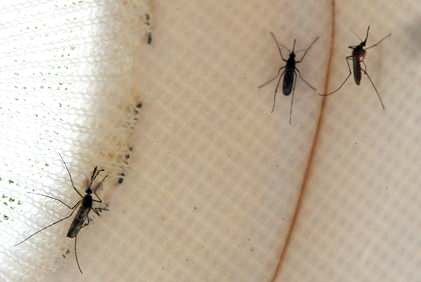It’s an unfair reality for a 54-year-old man who until last summer spent his free time working with his hands: fixing cars, hunting, picking a guitar.
“It’s hard to believe that a bug can do all this,” he says.
Langley was one of more than 1,800 Texans sickened by the mosquito-transmitted West Nile virus last year. Another 89 people were killed in what was the worst West Nile outbreak in the state’s history.
Texas was the epicenter, but West Nile reached far and wide in 2012. According to the Centers for Disease Control and Prevention, 5,674 West Nile-related illnesses and 286 deaths were reported across the U.S., making 2012 the deadliest year since the virus first appeared in the U.S. 14 years ago. California, Illinois, Louisiana, Michigan and Oklahoma also recorded fatalities in the double digits last year.
Human cases of West Nile infection have been mostly in decline since 2003, but last year’s strong resurgence suggests “unpredictable local and regional outbreaks” will reoccur, according to the authors of a recent study published in the Journal of the American Medical Association (JAMA).
“This is a national problem,” says Dr. Stephen Ostroff, a retired government epidemiologist.
Ostroff, in a JAMA editorial published this month, criticizes yearly federal funding for the prevention of mosquito-borne illnesses being slashed from nearly $35 million in the early 2000s to less than $10 million for 2012.
“Public health isn’t like a light switch. It isn’t something you can flick on and flick off,” Ostroff told Yahoo News. “There are too many people who think this was a problem 10 or 15 years ago and now we don’t have to worry about it.”

Langley before getting West Nile and while in the hospital last summer. (Courtesy photos)
“The only time I cared to use bug spray was when I was in the deep woods with brush up to my neck,” he says. “I never worried about it.”
Especially in his suburban backyard, 14 miles from downtown Dallas, which is where he believes he was when the mosquito bit him while he was repairing a fence the last weekend in June 2012.
“I get bit all the time and really didn’t pay it any attention,” Langley says. “I didn’t feel it right way.”
He continued reporting to work managing vehicles for the county, but sensed something wasn’t right.
“I wasn’t really sick, I just didn’t feel good,” says Langley, likening the early symptoms to a bad cold.
But a lack of energy and a headache quickly morphed into a fever of 106 degrees. His calves cramped and he was stumbling the morning his wife rushed him to the hospital.
Langley woke from a medically induced coma a month later to learn that he was paralyzed from the neck down and couldn’t breathe on his own.
“Quite frankly I looked dead,” he says of a photo taken of him in the hospital last July.
A year later, the virus is gone but the paralysis left him with extreme muscle weakness. His ventilator was removed in May and he’s now working with a therapist on trying to stand.
“Nobody says for sure what’s going to happen,” Langley says. “But I believe I’m going to make it back. I don’t have a doubt in my mind.”

Trapped mosquitoes can help predict outbreaks, researchers say. (File/Getty)
Dallas County, where Langley lives, reached epidemic numbers in 2012: More than 400 residents suffered mild to severe symptoms and 20 died. A new study on the Dallas outbreak reveals that researchers may have discovered ways of better pinpointing where West Nile virus will strike.
According to the findings published in the Journal of the American Medical Association, predictors include mild winters, breeding near dense residential areas, history of outbreaks and the number of virus-infected mosquitoes collected in traps.
“If you are going to wait for that human disease signal, you are way too late by then,” Ostroff told Yahoo News. “You need these earlier indicators of an emerging problem so that you can take steps to try and reduce the burden.”
With the peak infection season underway now through September, Ostroff urges the use of insect repellent and protective clothing (long sleeves, pants, socks).
“Even being outside for a few minutes at the wrong time when there’s lots of mosquitoes around that are carrying this virus is probably sufficient to transmit the infection,” he says. “There’s no major metropolitan area in the United States that could not have a Dallas scenario.”
Which is why Langley has a message for anyone who will listen: “Use bug spray, man.”
“I certainly wouldn’t want to visit any of my friends in the hospital the way they had to visit me,” he says. “That was awful.”



No comments:
Post a Comment